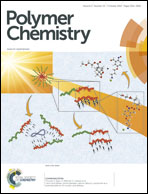Synthesis of donor–acceptor conjugated polymers based on benzo[1,2-b:4,5-b′]dithiophene and 2,1,3-benzothiadiazole via direct arylation polycondensation: towards efficient C–H activation in nonpolar solvents†
Abstract
This article describes the synthesis of donor–acceptor (D–A) type copolymers based on benzo[1,2-b:4,5-b′]dithiophene and 2,1,3-benzothiadiazole via direct-arylation cross-coupling polycondensation. To achieve high performance polymerization, we have systematically investigated the reaction factors including catalysts, solvents, ligands, bases, additives, concentration of reactants and phase transfer agents. In particular, 1,2-dimethylbenzene (ODMB), as a nonpolar high boiling point solvent, is a superior medium to perform this direct-arylation polymerization. In this nonpolar aromatic solvent, Pd2dba3/(o-MeOPh)3P, accompanied with a base potassium carbonate and an additive pivalic acid, serves as an efficient catalyst system to obtain high-quality polymers. Our optimized condition gave the polymer with a weight-average molecular weight (Mw) as high as 60 kg mol−1 in nearly quantitative yield and excellent C–H selectivity.
![Graphical abstract: Synthesis of donor–acceptor conjugated polymers based on benzo[1,2-b:4,5-b′]dithiophene and 2,1,3-benzothiadiazole via direct arylation polycondensation: towards efficient C–H activation in nonpolar solvents](/en/Image/Get?imageInfo.ImageType=GA&imageInfo.ImageIdentifier.ManuscriptID=C4PY00565A&imageInfo.ImageIdentifier.Year=2014)

 Please wait while we load your content...
Please wait while we load your content...